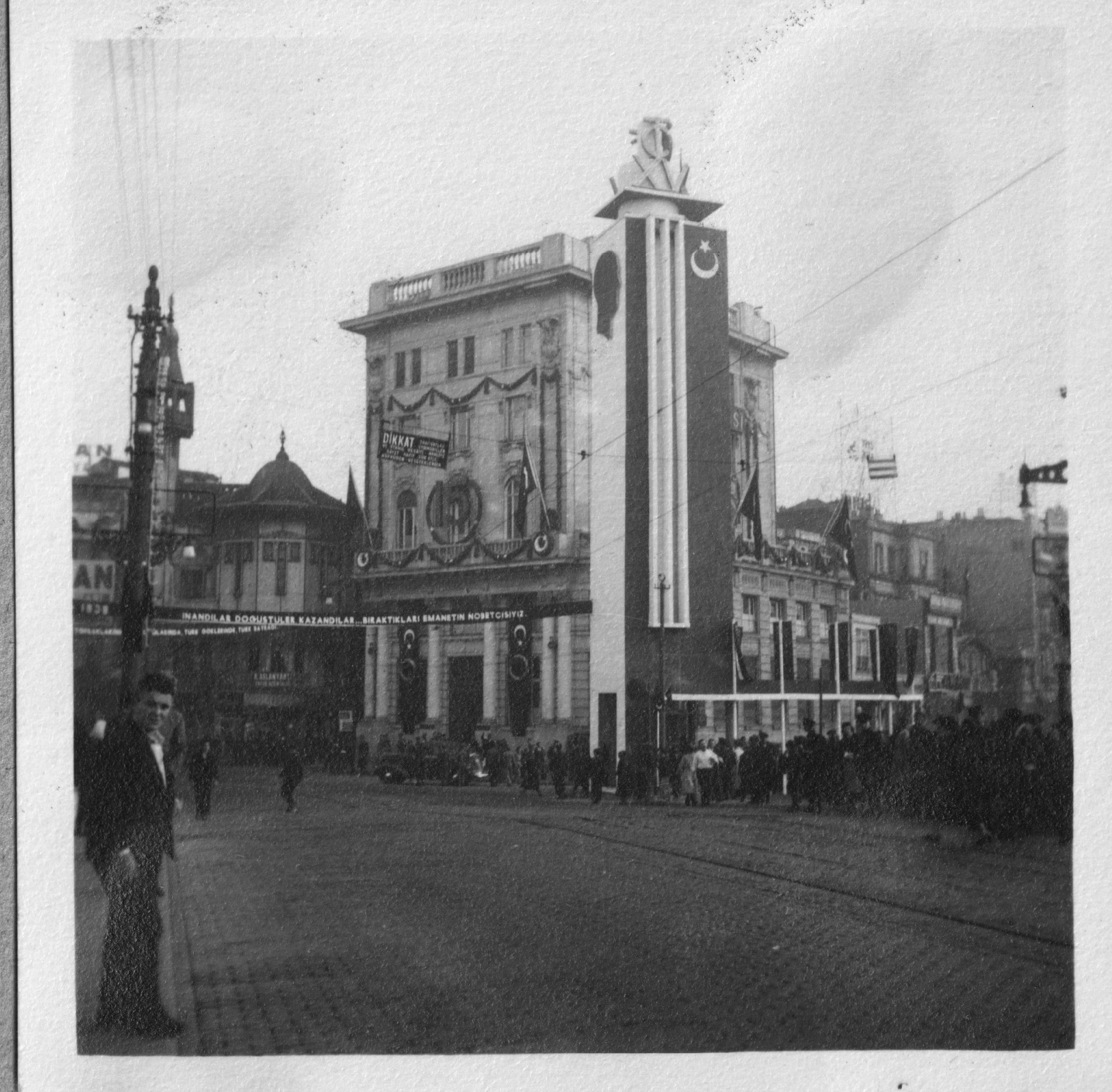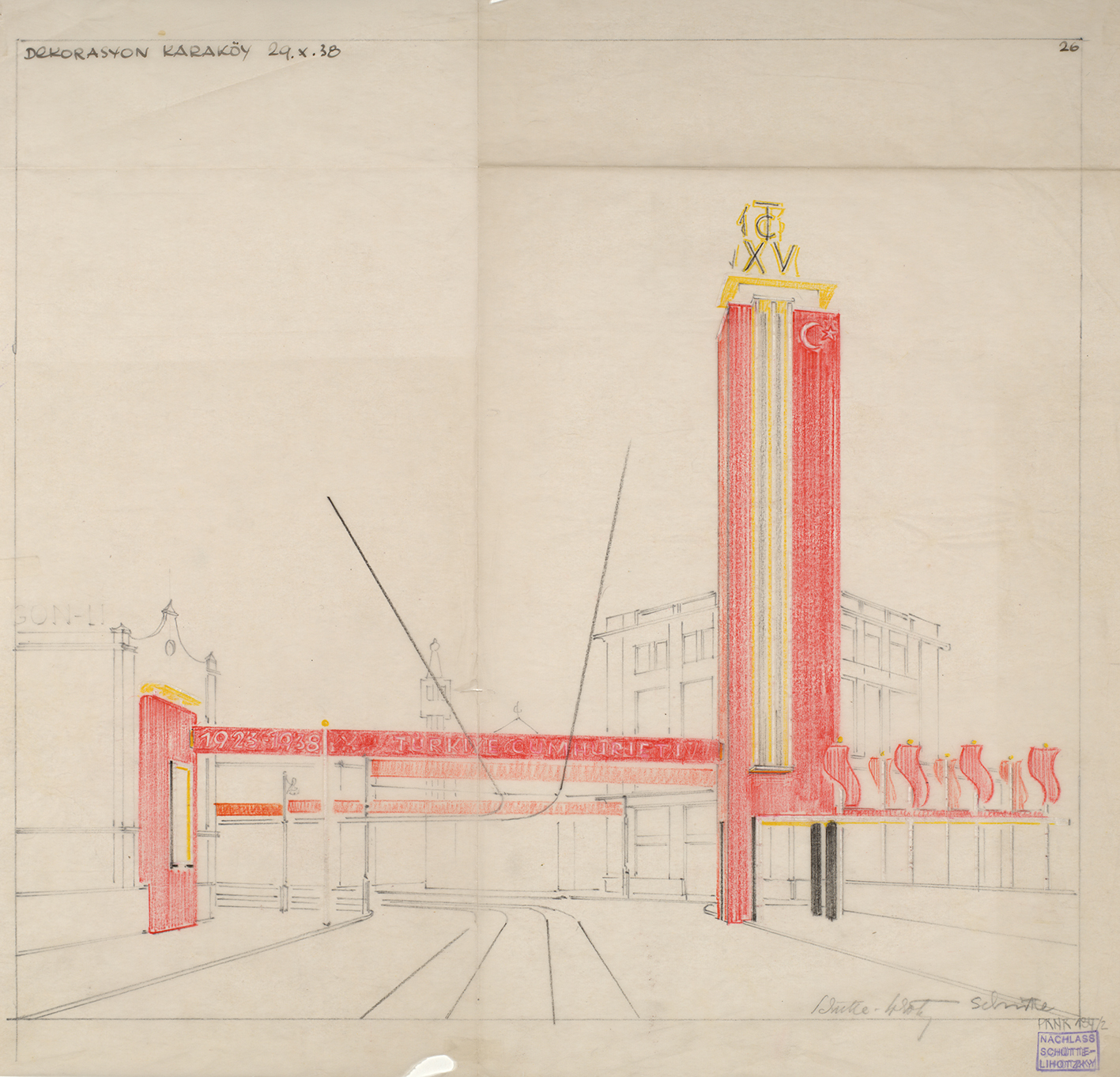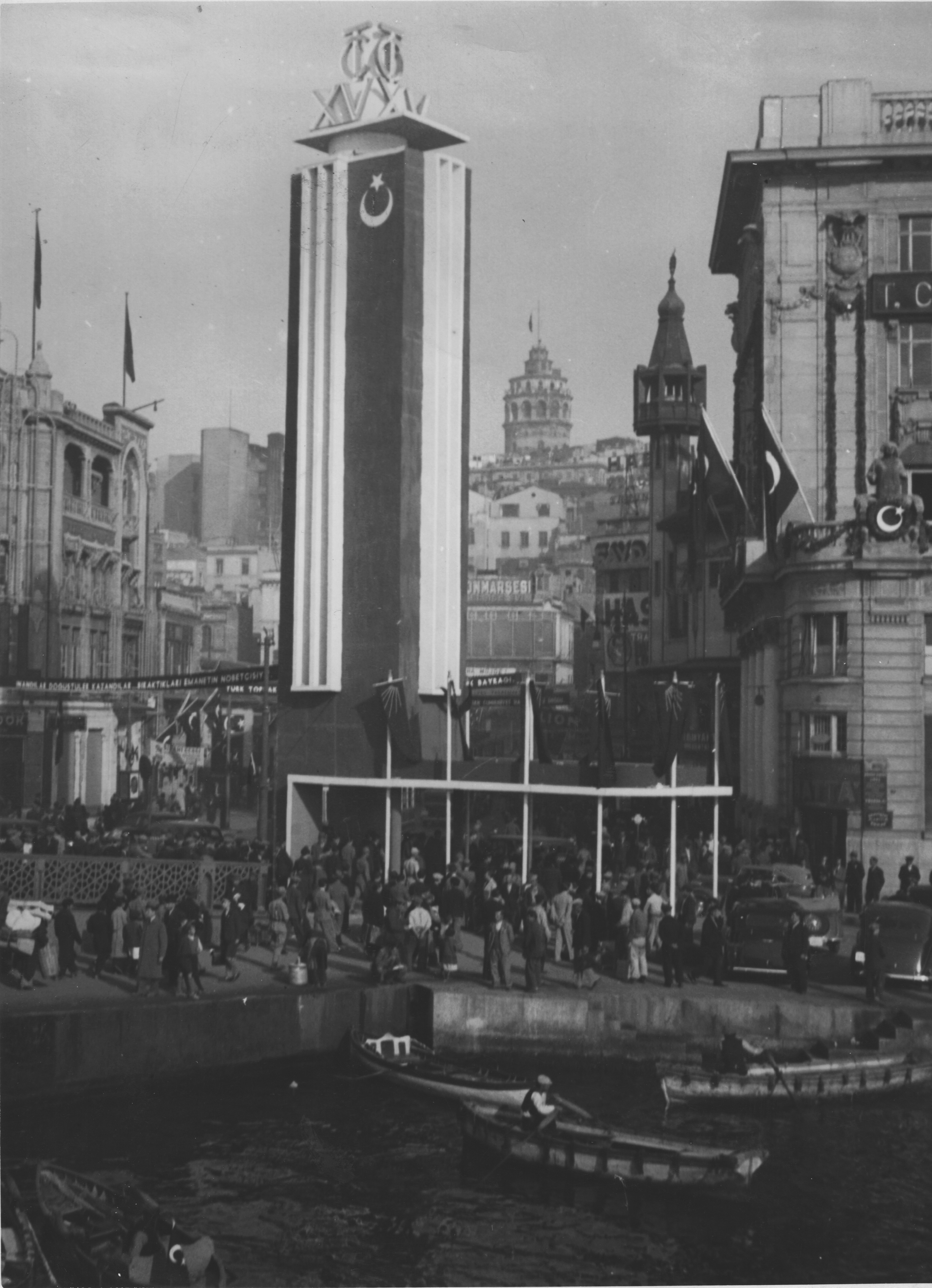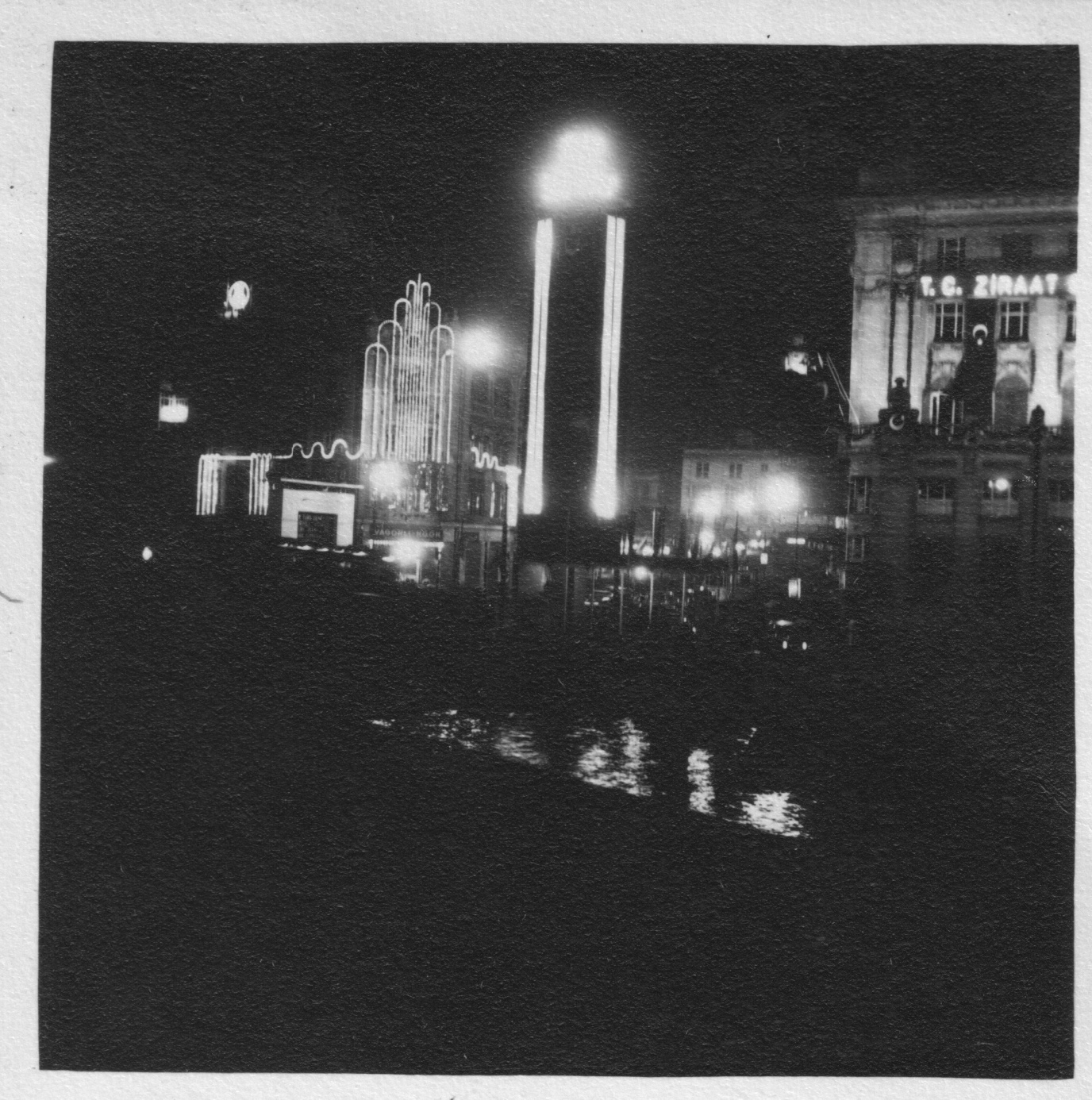Archive
Festive architecture for the 15th anniversary of the Turkish Republic
- Temporary street architecture
- Festive architecture for the 15th anniversary of the Turkish Republic
Word Count: 10
- Margarete Schütte-LihotzkyWilhelm Schütte
- 10-1938
- 10-1938
Kemankeş Karamustafa Paşa, Rıhtım Cd. No.1, Galata Köprüsü, Karaköy, Istanbul.
- Istanbul (TR)
One of the first commissions of the architects Margarete Schütte-Lihotzky and Wilhelm Schütte, who emigrated to Istanbul in 1938, was a street architecture for the anniversary of the Turkish Republic.
Word Count: 31

Margarete Schütte-Lihotzky and Wilhelm Schütte, Festive decoration for the 15th anniversary of the Turkish Republic, beginning of Galata Bridge, Istanbul-Karaköy, 1938, photograph by day (ÖGFA, Archive Wilhelm Schütte). 
Margarete Schütte-Lihotzky and Wilhelm Schütte, Festival Tower, festive decoration for the 15th anniversary of the Turkish Republic, beginning of Galata Bridge, Istanbul Karaköy, 29.10.1938, design drawing, coloured pencil and pencil on tracing paper, 38,5 x 41,5 cm (University of Applied Arts Vienna, Collection and Archive, Inv.No. 134/2. Reproduction: Robert Newald; © Luzie Lahtinen-Stransky). 
Margarete Schütte-Lihotzky and Wilhelm Schütte, Festive decoration for the 15th anniversary of the Turkish Republic, beginning of Galata Bridge, Istanbul-Karaköy, 1938, photograph by day, Galata tower at the rear (ÖGFA, Archive Wilhelm Schütte). 
Margarete Schütte-Lihotzky and Wilhelm Schütte, Festive decoration for the 15th anniversary of the Turkish Republic, beginning of Galata Bridge, Istanbul-Karaköy, 1938, photograph by night (ÖGFA, Archive Wilhelm Schütte). Dogramaci, Burcu. Kulturtransfer und nationale Identität. Deutschsprachige Architekten, Stadtplaner und Bildhauer in der Türkei nach 1927. Gebr. Mann, 2008.
Dogramaci, Burcu. Fotografieren und Forschen. Wissenschaftliche Expeditionen mit der Kamera im türkischen Exil nach 1933. Jonas, 2013.
Dogramaci, Burcu. “Architekt, Lehrer, Autor: Wilhelm Schütte in der Türkei (1938–1946).” Wilhelm Schütte. Architekt. Frankfurt, Moskau, Istanbul, Wien, edited by ÖGFA – Österreichische Gesellschaft für Architektur, Ute Waditschatka, Park Books, 2019, pp. 48–63.
Dogramaci, Burcu. “Intermezzo in Istanbul. Margarete Schütte-Lihotzkys Projekte im türkischen Exil.” Margarete Schütte-Lihotzky. Architektur. Politik. Geschlecht. Neue Perspektiven auf Leben und Werk (Edition Angewandte), edited by Marcel Bois and Bernadette Reinhold, Birkhäuser, 2019, pp. 126–139.
Neumann, Dietrich. “Leuchtende Bauten – Architekturen der Nacht.” Leuchtende Bauten – Architektur der Nacht, edited by Marion Ackermann, exh. cat. Kunstmuseum Stuttgart, Stuttgart, 2006, pp. 16–29.
Oechslin, Werner. “Licht. Ein Gestaltungsmittel zwischen Vernunft und Gefühl.” Daidalos, vol. 27, 1988, pp. 22–38.
Schütte, Wilhelm. Bericht über die Tätigkeit von Architekt W. Schütte im Tatbikatbürosu. Archive Wilhelm Schütte (ÖGFA – Österreichische Gesellschaft für Architektur, Wien, September 1938–September 1939).
Strigaljow, Anatoli. “Agitprop – die Kunst extremer politischer Situationen.” Berlin – Moskau 1900–1950, edited by Irina Antonowa and Jörn Merkert, exh. cat. Martin-Gropius-Bau, Berlin, 1995, pp. 111–117.
Word Count: 192
ÖGFA – Österreichische Gesellschaft für Architektur, Vienna, Archive Wilhelm Schütte.
University of Applied Arts Vienna, Collection and Archive, Estate Margarete Schütte-Lihotzky.
Word Count: 23
My deepest thanks go to ÖGFA – Österreichische Gesellschaft für Architektur, Vienna, to University of Applied Arts Vienna, Collection and Archive and to Luzie Lahtinen-Stransky, who gave me permission to reproduce the works of Margarete Schütte-Lihotzky and Wilhelm Schütte.
Word Count: 41
- Istanbul
- Burcu Dogramaci. "Festive architecture for the 15th anniversary of the Turkish Republic." METROMOD Archive, 2021, https://archive.metromod.net/viewer.p/69/2949/object/5140-10990319, last modified: 18-09-2021.
-
Margarete Schütte-Lihotzky and Wilhelm Schütte ApartmentResidenceIstanbul
The exiled architects Margarete Schütte-Lihotzky and Wilhelm Schütte lived from 1938 in an apartment in Kabataş, on the European side of Istanbul. The flat has been preserved in numerous photographs, allowing the interior design to be reconstructed. The view of the Bosporus from the balcony was spectacular.
Word Count: 48
Bruno Taut HouseResidenceIstanbulArchitect Bruno Taut’s house in Ortaköy stands on a hillside with a panoramic view of the Bosporus, located at the point where Asia and Europe are closest to one another.
Word Count: 32